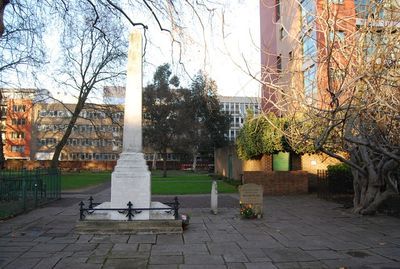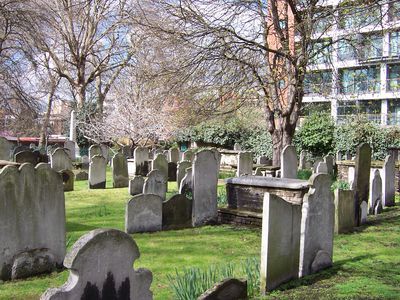Boris versus Bunhill
By MICHAEL CAINES
What would a country run by Boris Johnson be like? Hilarious? No doubt. What japes there will be when this Shakespeare biographer is running the show. I wonder if he'll also be doing more of this, too: turning London into a giant office and effectively overruling a Grade I listing in the process . . . .
Just off the City Road, on the edge of the Square Mile, Bunhill Fields is a modest park (around the size of two football pitches) where office workers take some green respite from their desks. The City of London officially describes it as an "an oasis of calm and greenery in a busy, congested locality". Yet it has a past life, if that's the right word, as a burial ground for Nonconformists; 120,000 people were buried there, it is believed, including a handful of writers: William Blake, Daniel Defoe, John Bunyan and Isaac Watts, the "Father of English Hymnody".
You can add to that list the "Mother of Methodism" Susannah Wesley; Blake's wife and assistant Catherine; "Lady Lewson", said to be one model for Miss Havisham; the Quaker George Whitehead; and hundreds of Dissenting ministers and figures of interest, including antiquaries, brave Dissenting booksellers, inventors and radical politicians, to whom memorials also stand in the pages of the ODNB.
Robert Southey could justly call Bunhill "the Campo Santo of the Dissenters", and the significance of this historical community, who were given the status of inferior citizens by the Test and Corporation Acts of the 1660s, remains insufficiently acknowledged. As Timothy Larsen wrote in the TLS last year:
"The enormous influence once wielded by British Nonconformists is often downplayed today. . . . Nonconformist cultural contributions still surround us in names we routinely evoke: Cadbury���s, the YMCA, Thomas Cook, Aston Villa, Barclays, the Tate and much more. Full-blooded Dissenters would have said that their most important legacy was spiritual: they had produced the greatest preachers (C. H. Spurgeon), missionaries (David Livingstone) and social reformers (Elizabeth Fry)."
Understandably, if belatedly, this park-and-long-retired-cemetery received a Grade I listing in 2011, "putting it into the top 10% of the 106 listed cemeteries in England", while many monuments were also simultaneously given Grade II listings. The theory is that such a listing affords a measure of protection against "any form of development or interference".
Well, now we know how the Mayor of London views a Grade I listing. Developers have proposed erecting four blocks of offices that will overlook, overshadow and overwhelm the park; one of the towers to be ten and another eleven storeys high. Islington Council, the Ancient Monuments Society and the Blake Society have opposed the plans, saying they would cause "significant harm" to a garden of "special historic interest". ���The newcomer is just too vast", observes the AMS. "Part of the character of Bunhill is that sense of modern life crowding in but not spoiling it ��� its mood is the more rarefied precisely because of that tension.���
Johnson's decision? To call in the planning application and approve it on February 8 ��� the third time in three years he has overruled the local council in favour of developers.
Of course, there is nothing unusual or necessarily wrong about a new office block going up in London. (I'm writing these words from a relatively new one myself.) We need more office space here, apparently, as well as cheaper housing (try finding that in shouting distance of Bunhill Fields). And the listing is not a means for freezing the whole local area in time, which partly concerns questions of curtilage (although as things stand, most adjacent buildings are no more than four or five storeys high). And, of course, we've been here before ��� or if not exactly here, certainly hereabouts. I don't object on principle to the skyline changing. It's the disregard for history and quality of urban life, the flouting of the rules and intimation of how Johnson chooses to govern that disappoints ��� just these few, minor foibles.
Not least as, in the meantime, the Blake Society has been campaigning for years to erect a "traditional gravestone" in the correct spot in Bunhill Fields, and have been restricted to making it a flat stone "due to planning restrictions", for which funds are still being raised.
Perhaps Johnson could try reading a spot of Iain Sinclair, who gives a vivid sense of Bunhill's present and past commingled in this lecture from 2007:
"On a morning like this, it would be wonderful, with the trees overhead, the dappled leaves ��� there is a large fig tree that hangs over Blake���s grave. And it���s a place that is not in the City. It���s just outside the walls of the original City. Because once you go beyond, the permissions begin to open up. The original theatres grew up just on the edge of the City. The brothels, the liberties, the asylums grew up in Hoxton, on the edge, and in Hackney, because they���re the suburbs of the City. And in this place too the dissenters are buried. And I go through that place and sit down because it is a relief from any journey across town . . . . The place on the edge of the City is a place of respite and resolution."
In any case, unless many more people sign this petition, "Boris Johnson: We ask you to halt the development of towerblocks by Bunhill Fields", and a dramatic reversal takes place, I look forward to seeing Dissent-free City workers eating their packed lunches in the shadow of a tower block where once the earth was more open to the sky.
Peter Stothard's Blog
- Peter Stothard's profile
- 30 followers





